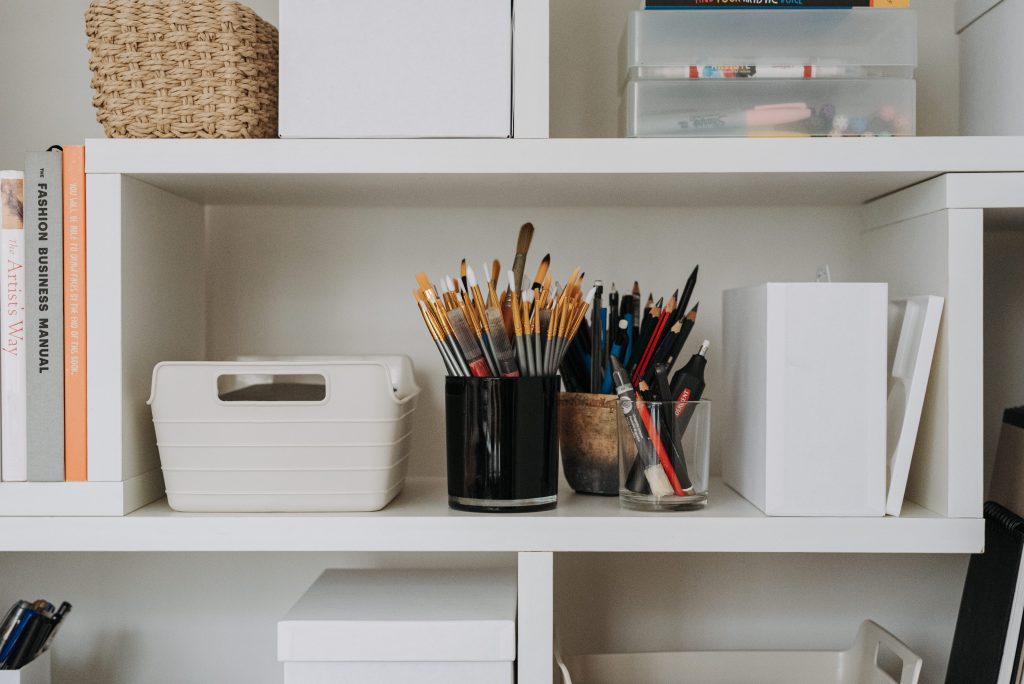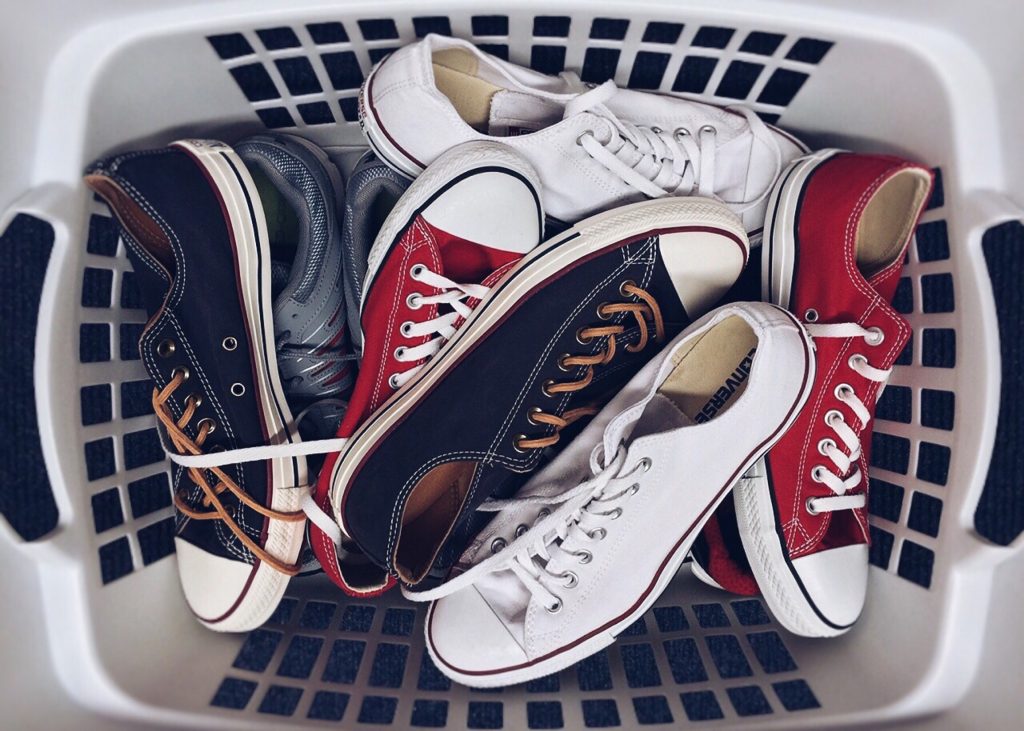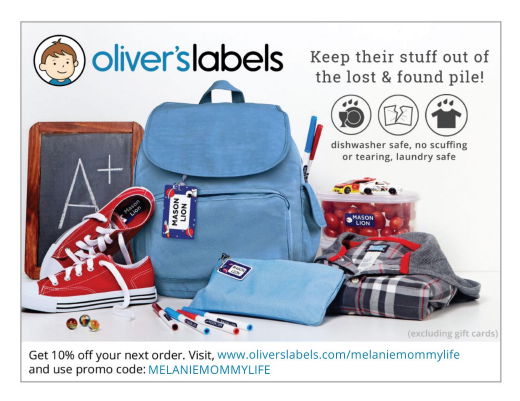
With the last few days of summer left, you’re starting to mentally prepare for the new school year. Back to school is a big deal and there are lots of moving parts. Getting your home in order will save you time and energy when the action happens.
I’ll cover decluttering, homework stations, family calendar system, and tips to make your home manageable.
Keep reading for steps on how you can prepare your home so your daily routine can run smoothly for back to school.
This post contains Amazon affiliate links. An affiliate link means at no extra cost to you, I earn a commission if you make a purchase through my link. Please read my Disclaimer for more details.
Decluttering your home in preparation for back-to-school
Decluttering an entire house in a short period of time is unrealistic and can cause a lot of unnecessary stress.
Choose one or two trouble zones in your home that you feel are making your home less productive and efficient.
Here are 3 simple steps to decluttering your home.
1.Toss the Junk First
A quick way to declutter is to remove any unused or broken items. This should be easy because all you’re focusing on is removing the stuff you know you are not using or that can’t be used because it’s broken, expired, etc.
Set a timer and move quickly at removing anything that need to be tossed. That’s it!
2.Set up Sorting Bins
The next stage after you’re done getting rid of unused, broken, or expired items, set up 4 sorting bins and label them the following:
- Keep
- Donate
- Sell
- Recycle
Figure out how much time you can commit to decluttering daily until it’s done. Whether you’re committing 15 minutes per day or 1 hour per day, choose what’s most feasible for you.
Let’s say you set a timer and declutter for 10 minutes daily. That’s 70 minutes per week, that’s over 5 hours per month. That’s a lot of decluttering progress for only 10 minutes a day. Commit to what works best for you.
A note about the Sell bin: If selling your old stuff sounds like too much work, skip the Sell bin and put it in the donate bin. For some people, it’s just not worth the time. If that’s you, that’s okay.
3.Ask These Important Questions
- Am I using this?
- How long has it been since I last used it?
- Is it valuable to me?
- If not valuable, is it worth keeping and taking up space in my home?
If you’re sentimental or hang on to stuff because you “might need it sometime later”, be careful. This kind of thinking can keep clutter in your home.
Avoid the “Just in case” mindset. You might realize that your “just in case” item never came to be useful and stayed in your home as clutter.
Another good rule of thumb is if you forgot you had it, then there’s a good chance you don’t need it. If you stored away items and it’s still sitting in a storage for a year or longer, there’s a good chance you won’t use it again. These are good indications it can go for good.
Recommended Storage & Organization at Amazon
Tips to Help Make Decluttering Easier
Share the responsibility or hire help.
I’m going to assume that you’re not the only person in your household that brings stuff into the home. Get family members to help with decluttering. If you really, really hate the idea of decluttering, hire someone to do it for you.
Be mindful when shopping.
If tempted to buy something, always ask yourself what purpose it will serve and if you will use it immediately. If you can’t answer those questions, it’s best to sleep on it.
Ideally, choose to buy things you know will serve a purpose and make your life easier or more enjoyable. Giving yourself some time to think about it can help prevent you from bringing in stuff you won’t use in your home.
Apply the One-In, One-Out rule.
For every item you buy, remove the same number of existing items from the home. I’ve been applying this rule and it’s working to keep the clutter down.
Set a reminder on your phone.
It is an easy and effective way to hold you accountable. It can also help you build a decluttering routine as keeping a home clutter-free is an ongoing process.
Set a timer to keep you on track.
Sometimes we can get distracted or procrastination sets in. Timers are a great way to stay focused and motivated to get something done.
Try borrowing or renting.
Sometimes you need something temporarily or want to buy but unsure if it will be useful, try borrowing or renting.

Habits to keep high traffic zones organized
Naturally, areas of your home that are high traffic are more prone to disorder. Areas like the kitchen, living room or family room would benefit from a routine to keep the space clear and organized. Maintaining good organization habits can improve flow and efficiency.
Keep stuff to a minimum.
Keep only what you need and use regularly. Easier said than done but like all habits, it takes persistence and practice. When you want to buy something, ask yourself whether or not you can use it regularly. Is it essential or is it nice to have?
Use storage bins wisely.
Storage bins or baskets can be really convenient. Kids can toss their books, supplies, or games in the bins and the floors remain clutter free. However, too many storage bins mean you’re more likely to accumulate stuff to fill the bins.
If you want to maintain your high traffic space easily, limit the amount of storage bins to prevent accumulating extra stuff. Put only what you need in a designated place and make it a habit to put back after use.
Create a command center
Have a command center or family bulletin board in the kitchen and/or your home entryway. A command center can help keep everyday items in order and within reach. Keys, wallets, bags, shoes, jackets, and mail can get lost in the house making school mornings frustrating and chaotic.
Think of it as your central hub that consolidates your family’s information, schedule, calendar, shopping list, memos, etc.
It makes the morning routine easier since it’s all in one place. There are many ways to create a command center. There’s trendy, minimalist, color themed, there are many options.
First, decide what your command center needs. Yours might have only a calendar with some hooks and a cubby or it can have more. It’s up to you.
Keep in mind you don’t need an entire wall to create a useful command center. It can still work in a small space. If you need inspiration, check out this great resource.
Recommended: Create a Stress-Free Home with a Family Command Center
The Homework Zone
With your kids back to school there will be homework. Decide on a quiet and neat space for kids to focus. A dedicated homework station can make doing schoolwork more enjoyable, prevent distractions, and keep school supplies organized too.
Another bonus to having a workstation is that it can build self-management and organization skills.
A homework station can be small and portable too. No need to use an entire room. There are plenty of space saving options that will have your kids excited to do their homework.
Get your kids involved and ask for their feedback on what they like. Work with them to create a fun but neat space conducive to focus and learning. Here are some great ideas for homework stations for back to school.
Labelling for Organization
Labels are great to help you and your family get organized for back-to-school.
When you have kids, you can never have too many labels. If you have multiple kids, labels are especially helpful as they know exactly which items are theirs. No more fighting over stuff and no worrying about anything getting lost, making everyone’s life a little easier.
Labels for the home can be used for bins, files/folders, clothing, containers, and of course school supplies.
Blank labels are great because you can write what you want on them. If you prefer a customized design, pre-printed labels are a good choice as you can customize font, color, and design.
For kids labels, Oliver’s Labels is an excellent choice. They have a wide variety of label types, styles and themes. My kids love the MyMoji™ and YOUnique™ sticker labels. Check out what they have to offer here and use my coupon code: MELANIEMOMMYLIFE to get a discount.
When labeling school supplies, you can use color-coded and/or icon labels to help your child easily identify their things.
Other ways to label your child’s school supplies and gear: washi tape, sharpie, and stickers.
What to label:
- Pencil cases/Boxes
- Notebooks, folders, binders
- Books, textbooks
- Lunch box/bag
- Water bottles, thermos container, cold packs
- Backpack
- Devices: Tablet, laptops, headphones, adapters/charging cables.
- Clothing: shoes, clothes including emergency clothes, hats, gloves, jackets, ski pants
Recommended Labels at Amazon
Maintaining a Family Schedule
Family Calendar System
Are you thinking about your family calendar system yet? If you haven’t, don’t worry. Here are some tips on how you can get started.
Before creating your family calendar, get all the information you can about the school schedule, teachers, students, and any new rules or policies. After that, you can start thinking about what you want your weekly schedule to look like.
Getting a head start on your family calendar for the school year will make it easier to ease back into a structured routine.
Figure out family goals
Thinking about your family goals now will help you focus on things that matter to you, making scheduling simpler.
Are you looking to fit in more family time, less overtime at work?
Maybe you want your kids to participate in more/less after-school activities.
Worried about homework?
Worried about mornings and being late?
Tackle your biggest concern and focus on making it better. You can be even more proactive by anticipating any snags or stressors that can occur in your daily routine.
For example, your family might struggle with getting out the door on time.
Think about your daily routine and brainstorm any changes that can be made to make it easier to be ready in the morning.
In this post on how to create a better family routine, I guide you through everything you need to consider when creating your best routine. It’s worth giving it a quick read.
Recommended: 5-Step Guide to a Better Family Routine (Back-to-School)
Create an Easy-to-Follow Calendar
How you set up your calendar is going to make or break a good schedule. A calendar that’s overpacked and disorganized will make for a very difficult schedule to follow.
Decide if you want a paper, digital, or whiteboard calendar. Stick with what you know works best for you and your family.
If you’re not sure what’s best, now is the time to figure that out. In general, most people have a preference for paper and like writing things down.
If you work outside the home and expect to be traveling a lot whether that be for work or because you have kids to transport to and from, a digital calendar might be best.
Both can offer portability but, in my opinion, a digital calendar like Google Calendar might offer more flexibility for you and your family.
Keep in mind that your schedule can change. There might be some trial and error before attaining the right schedule for your family.
Review it regularly to see what is and isn’t working. It’s a bit of maintenance but worth it.
Scheduling methods to make like easier
Now that you’ve established family goals, acquired all the necessary information regarding school, and have chosen your preferred calendar type, it’s time to think about efficiency.
When you create your family schedule, do you consider the amount of time you use?
Just like a to-do list, you can overpack a calendar with unnecessary tasks doing more than you need to. This steals precious time you could use for more important things.
Recommended: 5 Simple Steps to Prioritizing Tasks to Win the Day
There are ways you can avoid this like time blocking and task batching.
Time blocking are blocks of time you dedicate to a particular task. With task batching, you can batch similar tasks in a block of time.
For example, your after-school routine can have a block of time between 4-6pm with tasks like meal prep (washing, chopping food), cooking, plating, storing extras, packing next day lunches, and quick cleanup.
This doesn’t have to be your routine but it’s an example of how much you can get done when you batch similar tasks in a block of time.
What’s really cool about time blocking and batching, is that you can get a lot done without a huge to-do list. Working from a long to-do list is more overwhelming than breaking down tasks in blocks. It’s much more manageable.
Family schedule tips:
- Have a meeting to review your schedule once a week with your family to discuss activities, events, deadlines, home tasks, and/or other arrangements.
- Use color coding for quick and easy glance. Example, each family member can be given a color so you can see where they are on the schedule quickly without reading.
- Keep track of what is and isn’t working with your schedule.
- Avoid overscheduling, and prioritize urgent and important tasks.
- Keep your family calendar simple, avoid multiple calendars if possible.
- Use digital calendars or free apps.
While it might be tempting to wait to prepare for back to school, getting your home in order now will give you a better idea of what you and your family needs for an easier daily routine.
Don’t forget your family is a team so getting everyone to work together will make preparation less daunting and more motivating.








